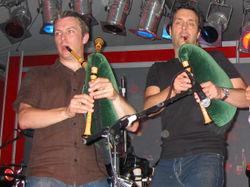Pibau Cymreig: Gwahaniaeth rhwng fersiynau
Cynnwys wedi'i ddileu Cynnwys wedi'i ychwanegu
Holder (sgwrs | cyfraniadau) B corr |
|||
| Llinell 16: | Llinell 16: | ||
Pibgorn (Welsh lit. "pipe horn")- A number of examples of this instrument survive, these date from the 17th and 18th centuries. The pibgorn is a mouthblown hornpipe, having a parallel bore, six finger holes and a thumb hole. The pipe has a cowhorn mouth piece and an intricately carved cowhorn bell. The reed is of the single beating type usually made of cane but some players now use synthetic reeds. Modern pibgyrn (pl.) play in the key of D using open fingering, with many tunes in E minor. |
Pibgorn (Welsh lit. "pipe horn")- A number of examples of this instrument survive, these date from the 17th and 18th centuries. The pibgorn is a mouthblown hornpipe, having a parallel bore, six finger holes and a thumb hole. The pipe has a cowhorn mouth piece and an intricately carved cowhorn bell. The reed is of the single beating type usually made of cane but some players now use synthetic reeds. Modern pibgyrn (pl.) play in the key of D using open fingering, with many tunes in E minor. |
||
A further development (probably a redevelopment) of the pibgorn are the pibau cyrn where the pibgorn is played with a mouthblown bag and a bass drone playing an octave below the tonic |
A further development (probably a redevelopment) of the pibgorn are the pibau cyrn where the pibgorn is played with a mouthblown bag and a bass drone playing an octave below the tonic. A notable player of these pipes is Ceri Rhys Matthews who has done much to ignite the interest of many in this revival. Makers include John Glennydd of Carmarthenshire and John Tose from Pembrokeshire. |
||
Another development of piping in Wales has been the making of mouth blown pibau cwd, pibgwd or bacbib which are based on the veuze and Galician gaita. They have a steep conically bored chanter with seven finger holes and thumb hole with a double reed and a single base drone usually tuned two octaves below the tonic. Drones are also tuned to one note below the tonic for minor tunes. Welsh pipers most often play bagpipes in the key of D but other keys are also used, particularly C or B#. |
Another development of piping in Wales has been the making of mouth blown pibau cwd, pibgwd or bacbib which are based on the veuze and Galician gaita. They have a steep conically bored chanter with seven finger holes and thumb hole with a double reed and a single base drone usually tuned two octaves below the tonic. Drones are also tuned to one note below the tonic for minor tunes. Welsh pipers most often play bagpipes in the key of D but other keys are also used, particularly C or B#. |
||
Fersiwn yn ôl 19:16, 29 Medi 2019

Offerynnau cerdd yw'r pibau Cymreig. Ceir sawl math, e.e. pibgorn, côd-biban, pibgod, pibgwd, pibau cyrn, pibau cwd, bacbib, pibau gwynt.
Ceir tystiolaeth am bibau gwynt yng Nghymru o'r 10g ymlaen, ond bu i'r traddodiad farw erbyn diwedd y 19g oherywdd newid mewn ffasiwn a chwaeth cerddorol a dylanwad y mudiad Methodistaidd a filwriodd, ar y cychwyn, yn erbyn cerddoriaeth 'werin' am resymau crefyddol. Erbyn hyn, dim ond un enghraifft o bibau gwynt Cymreig a geir, a hynny yn Amgueddfa Werin Cymru, Sain Ffagan.
Serch hynny, cafwyd adfywiad mewn diddordeb mewn canu'r pibau ers yr 1980au.
Dolenni
- Pibau Cymru Erthygl ar wefan 'Lleoli i Mi' y Gogledd Orllewin y BBC
- Welsh Bagpipe Welsh Hornpipe: Blog am bibau Cymraeig gan Ceri Rhys Matthews (Saesneg)
- Pibydd Glantywi: Blog dwyieithog gan bibau Cymreig
